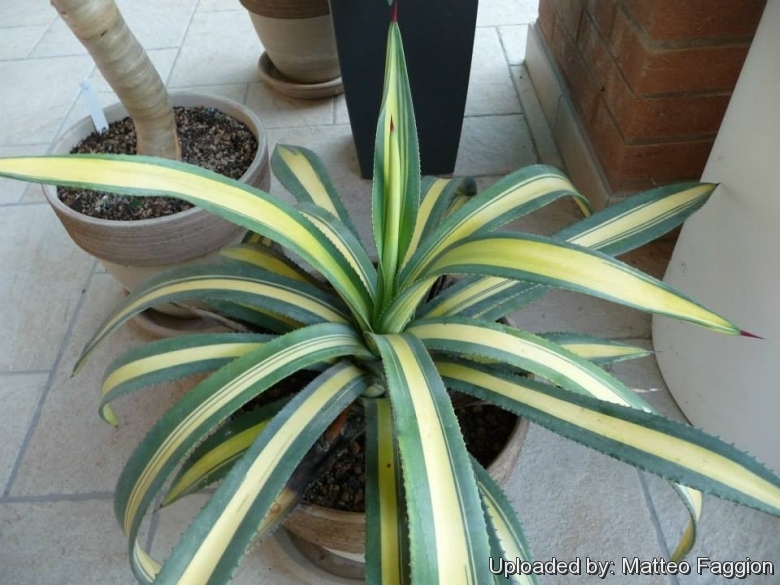
Agave murpheyi f. variegata Photo by: Matteo Faggion
Origin and Habitat: Garden origin
Synonyms:
See all synonyms of Agave murpheyi
Description: Agave murpheyi f. variegata is a medium sized agave that forms rosettes to 60-90 cm tall by 90 cm across with straight upright medium light green 60 cm long leaves that are yellow banded with small teeth widely spaced along the margin - the variegation on the leaf is often just strong yellow margins but occasionally there are multiple yellow stripes in the middle of the leaf and sometimes the leaf seems more yellow than green. Offsets quickly. The green-tinged purple flowers on this species, held on a compact branching spike within the top third of its 10 to 12 foot overall height, are accompanied by many bulbils in the flower axils. This beautiful rare variegated agave is a outstanding plant that worth a place in every variegate Agave collection.
Leaves: 50-65x 6-8 cm, linear to spatulate (, widest above the middle), firm, short-acuminate, straight or curling slightly toward the centre, light glaucous green to yellowish green, yellow banded with small teeth widely spaced along the margin - the variegation on the leaf is often just strong yellow margins but occasionally there are multiple yellow stripes in the middle of the leaf and sometimes the leaf seems more yellow than green. The margin iis undulate with small single, regular teeth 3-4 mm long, mostly 1-2 cm apart, bases brown, cusps greying. Apical spines short, 12-20 mm long, conic, very shortly grooved or flattened above, dark brown becoming greyish. The leaves develop a yellowish-red coloration during flowering.
Inflorescence: Narrowly paniculate. The stalk may and attains an height of 3-4 metres. Lateral branches 10 to 20, slightly ascending, longer than 10 cm. June, these lateral branches bloom with normal-looking flowers, attract a variety of potential pollinators, but don't produce any mature fruit. Instead, by the summer monsoon season of July and August, the mother plant produce hundreds of miniature agaves or bulbils in these upper side branches. The bulbils appear to arise at the nodes from enlargements of tissue in the vicinity of the former flowers. Without releasing on their own, these bulbils became water-stressed and had to be forcibly removed a year later. By this time they appear quite variable in fresh weight and size. Once planted, they rehydrate and immediately begin to grow. A. murpheyi is probably self-incompatible requiring outcrossing.
Flowers: Flowers 12–21 per cluster, erect, greenish with purple or brown tips and are up to 5-7.5 centimetres long.
Subspecies, varieties, forms and cultivars of plants belonging to the Agave murpheyi group
Bibliography: Major references and further lectures
1) San Marcos Growers contributors “Agave murpheyi 'Engard' - Variegated Hohokam Agave ” San Marcos Growers <http://www.smgrowers.com>. Web. 27 Sep. 2014.
2) Gentry, H. S. “Agaves of continental North America”. University Arizona Press, Tucson, Arizona.1982.
3) Wikipedia contributors. "Agave murpheyi." Wikipedia, The Free Encyclopedia. Wikipedia, The Free Encyclopedia, 9 Jan. 2016. Web. 7 Apr. 2016.
4) Arizona-Sonora Desert Museum (Tucson, Ariz.) “A Natural History of the Sonoran Desert” University of California Press, 2000
5) Mary Irish “Gardening in the Desert: A Guide to Plant Selection & Care” University of Arizona Press, 2000
6) Boyce Thompson Institute for Plant Research “Contributions”, Volumi 7-8 1935
7) Carlos E. González Vicente, William H. Moir, Instituto Nacional de Investigaciones Forestales y Agropecuarias (Mexico), Rocky Mountain Forest and Range Experiment Station (Fort Collins, Colo.), United States. Forest Service. Southwestern Region “Strategies for classification and management of native vegetation for food production in arid zones” The Station, 1988
8) Rex K. Adams “How does our agave grow? Reproductive biology of a suspected ancient Arizona cultivar, Agave murpheyi Gibson.” Desert Plants 14(2) 11-20. 1998, retrieved 07 April 2016 from <http://eebweb.arizona.edu/courses/ecol414_514/readings/agave.pdf>
9) Agave murpheyi. in: F. Gibson, Contributions from Boyce Thompson Institute 7(1): 83-85, f. 1. 1935.
10) Agave murpheyi. Plant Abstracts. Arizona Game and Fish Department.
11) Arizona Game and Fish Department. 2003-05-08 Agave murpheyi. Unpublished abstract compiled and edited by the Heritage Data Management System, Arizona Game and Fish Department, Phoenix, AZ. X pp. Retrieved 07 April 2016 from <http://www.azgfd.gov/w_c/edits/documents/Agavmurp.fo_002.pdf>
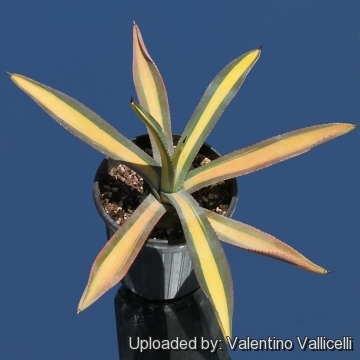 Agave murpheyi f. variegata Photo by: Valentino Vallicelli
Agave murpheyi f. variegata Photo by: Valentino Vallicelli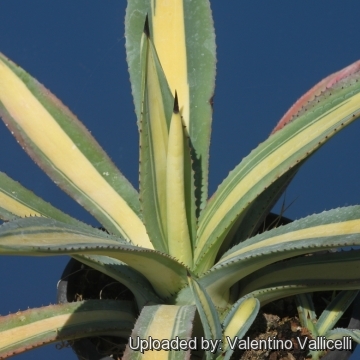 Agave murpheyi f. variegata Photo by: Valentino Vallicelli
Agave murpheyi f. variegata Photo by: Valentino Vallicelli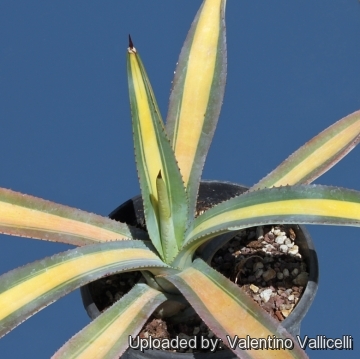 Agave murpheyi f. variegata Photo by: Valentino Vallicelli
Agave murpheyi f. variegata Photo by: Valentino Vallicelli Agave murpheyi f. variegata Photo by: Valentino Vallicelli
Agave murpheyi f. variegata Photo by: Valentino Vallicelli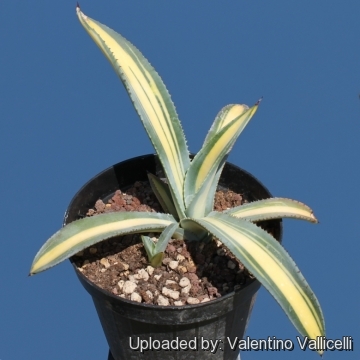 Agave murpheyi f. variegata Photo by: Valentino Vallicelli
Agave murpheyi f. variegata Photo by: Valentino Vallicelli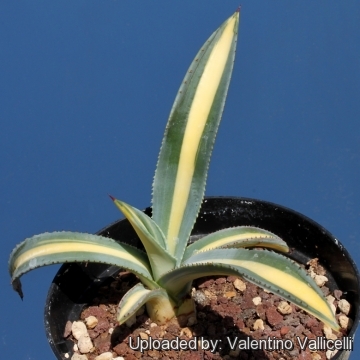 Agave murpheyi f. variegata Photo by: Valentino Vallicelli
Agave murpheyi f. variegata Photo by: Valentino Vallicelli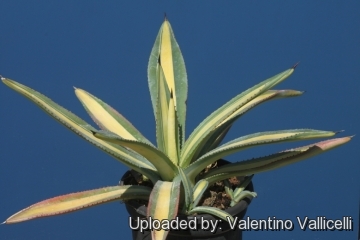 Agave murpheyi f. variegata Photo by: Valentino Vallicelli
Agave murpheyi f. variegata Photo by: Valentino VallicelliSend a photo of this plant.The gallery now contains thousands of pictures, however it is possible to do even more. We are, of course, seeking photos of species not yet shown in the gallery but not only that, we are also looking for better pictures than those already present.
Read More... Cultivation and Propagation: This is a splendid ornamental Agave and one of the most striking variegated cultivars. It is an easy-to-grow plant that could well be valued and cultivated by the sophisticated agave fanciers.
Soil: It needs a very well-drained, soil.
Repotting: Use pot with good drainage.
Watering: Water regularly during the growing season from spring to autumn. In winter watering this plant can be done once every 1-2 months, there is no need to mist the leaves.
Exposure: It do well in full sun or a lightly shaded area.
Feeding: During the beautiful season it’s good to enrich the soil using a fertilizer rich in potassium and phosphorous, but poor in nitrogen, because this chemical element doesn’t help the development of succulent plants, making them too soft and full of water.
Hardiness: It is reputed hardy to -12° C, particularly when dry, but it is best to avoid freezing temperatures.
Garden uses: Because of its symmetrical and colourful leaves this plant is very attractive when grown in pots and containers. They are quite versatile. Plants can be grouped together or planted among boulders in a rock or cactus garden.
Propagation: The primary mode of reproduction is vegetative by rhizomatous off-sets called "pups." It also reproduces vegetatively by means of basal suckers or stolons. Remove the basal suckers in spring or summer and let the cuttings dry for a few days before inserting in compost.

















